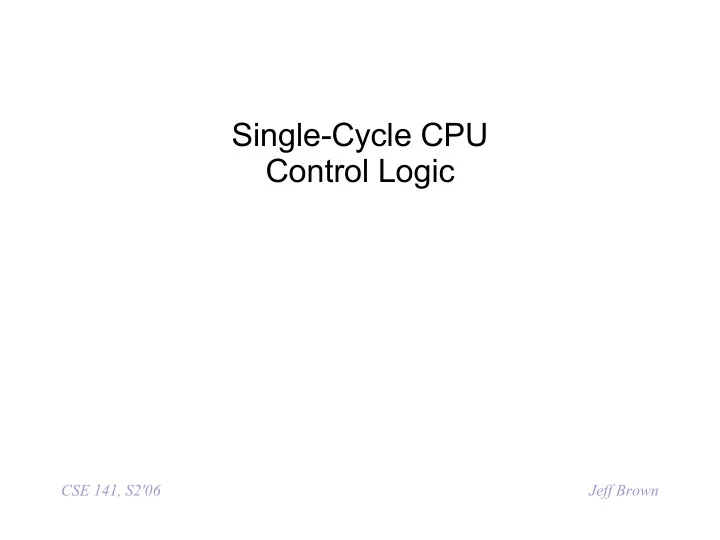

Single-Cycle CPU Control Logic CSE 141, S2'06 Jeff Brown
Putting it All Together: A Single Cycle Datapath • We have everything except control signals CSE 141, S2'06 Jeff Brown
Okay, then, what about those Control Signals? CSE 141, S2'06 Jeff Brown
ALU control bits • Recall: 5-function ALU ALU control input Function Operations 000 And and 001 Or or 010 Add add, lw, sw 110 Subtract sub, beq 111 Slt slt • based on opcode (bits 31-26) and function code (bits 5-0) from instruction • ALU doesn’t need to know all opcodes--we will summarize opcode with ALUOp (2 bits): 00 - lw,sw 01 - beq 10 - R-format func ALU op 6 ALUctrl Main ALUop Control 6 3 Control 2 CSE 141, S2'06 Jeff Brown
Generating ALU control Instruction ALUOp Instruction Function Desired ALU opcode operation code ALU control action input lw 00 load word xxxxxx add 010 sw 00 store word xxxxxx add 010 beq 01 branch eq xxxxxx subtract 110 R-type 10 add 100000 add 010 R-type 10 subtract 100010 subtract 110 R-type 10 AND 100100 and 000 R-type 10 OR 100101 or 001 R-type 10 slt 101010 slt 111 ALU Control Logic CSE 141, S2'06 Jeff Brown
Generating individual ALU signals ALUop Function ALUCtrl signals 00 xxxx 010 01 xxxx 110 ALUctr2 = 10 0000 010 ALUctr1 = 10 0010 110 10 0100 000 ALUctr0 = 10 0101 001 10 1010 111 func op ALUctrl ALU 6 Main ALUop Control 6 3 Control 2 CSE 141, S2'06 Jeff Brown
R-Format Instructions (e.g., Add) Memto- Reg Mem Mem Instruction RegDst ALUSrc Reg Write Read Write Branch ALUOp1 ALUp0 R-format 1 0 0 0 lw 0 0 sw 0 1 beq
lw Control Memto- Reg Mem Mem Instruction RegDst ALUSrc Reg Write Read Write Branch ALUOp1 ALUp0 R-format 1 0 0 1 0 0 0 1 0 0 0 lw 0 0 sw 0 1 beq
sw Control Memto- Reg Mem Mem Instruction RegDst ALUSrc Reg Write Read Write Branch ALUOp1 ALUp0 R-format 1 0 0 1 0 0 0 1 0 0 1 1 1 1 0 0 0 0 lw 0 0 sw 0 1 beq
beq Control Memto- Reg Mem Mem Instruction RegDst ALUSrc Reg Write Read Write Branch ALUOp1 ALUp0 R-format 1 0 0 1 0 0 0 1 0 0 1 1 1 1 0 0 0 0 lw X 1 X 0 0 1 0 0 0 sw 0 1 beq
Control Truth Table R-format lw sw beq 000000 100011 101011 000100 Opcode RegDst 1 0 x x ALUSrc 0 1 1 0 MemtoReg 0 1 x x RegWrite 1 1 0 0 Outputs MemRead 0 1 0 0 MemWrite 0 0 1 0 Branch 0 0 0 1 ALUOp1 1 0 0 0 ALUOp0 0 0 0 1 CSE 141, S2'06 Jeff Brown
Control • Simple combinational logic (truth tables) Inputs Op5 Op4 ALUOp Op3 ALU control block Op2 ALUOp0 Op1 ALUOp1 Op0 Operation2 F3 Outputs R-format Iw sw beq Operation RegDst F2 Operation1 F (5– 0) ALUSrc F1 MemtoReg Operation0 F0 RegWrite MemRead MemWrite Branch ALUOp1 ALUOpO CSE 141, S2'06 Jeff Brown
Single-Cycle CPU Summary • Easy, particularly the control • Which instruction takes the longest? By how much? Why is that a problem? • ET = IC * CPI * CT • What else can we do? • When does a multi-cycle implementation make sense? – e.g., 70% of instructions take 75 ns, 30% take 200 ns? – suppose 20% overhead for extra latches • Real machines have much more variable instruction latencies than this. CSE 141, S2'06 Jeff Brown
Recommend
More recommend